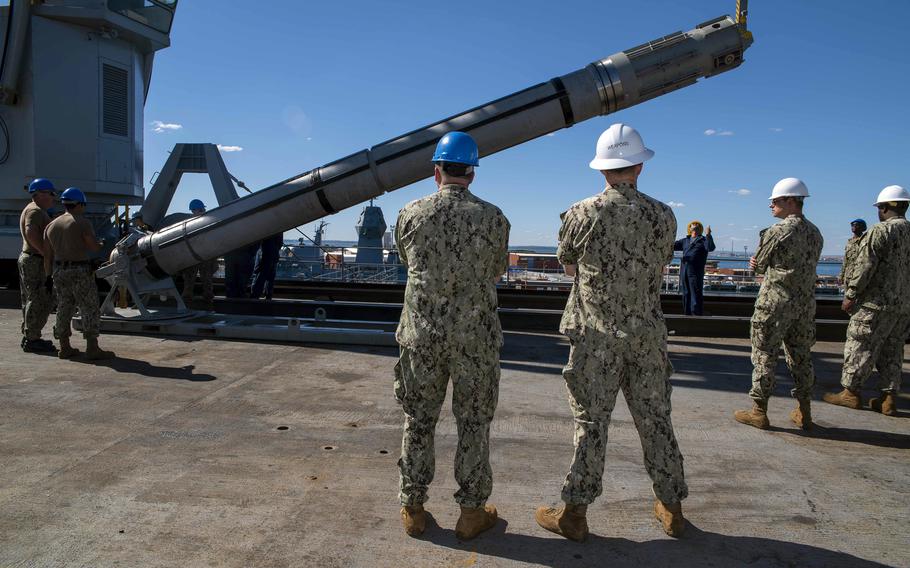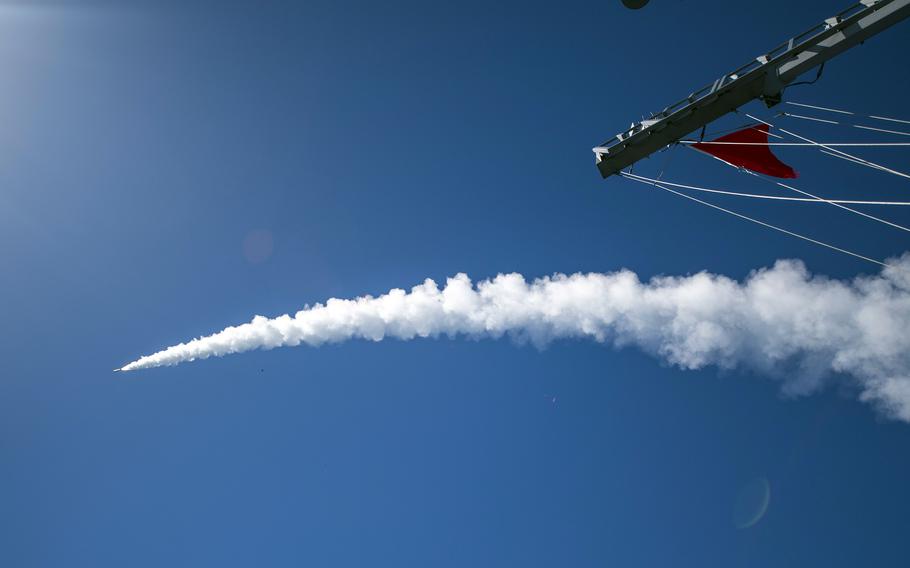
Japan is considering new defensive measures that may include purchasing Tomahawk missiles, seen here being offloaded from the USS Frank Cable on April 24, 2022. (Charlotte Oliver/U.S. Navy)
TOKYO — Japan’s Ministry of Defense said this week it’s interested in spending more on defensive weaponry but declined to confirm reports that it may buy 500 Tomahawk cruise missiles from the United States.
Two Japanese media outlets, Mainichi Shimbun and Kyodo News, citing unnamed government sources, reported this week that Japan is considering buying the Tomahawks.
The missiles would be purchased over time until the 2027 fiscal year to enhance the country’s defensive and deterrence capabilities, according to the reports.
A Defense Ministry spokesman on Thursday told Stars and Stripes that the Japanese government is making progress evaluating various options to strengthen its defense capabilities, but he declined to say what options, including equipment, was being evaluated.
"To fundamentally enhance defense capabilities, the Ministry of Defense is speeding up the realistic examination process without excluding all options and is collecting various information,” the spokesman said by phone.
Some government officials in Japan customarily speak to the media on condition of anonymity as a condition of their employment.

A tomahawk missile is launched from the guided-missile destroyer USS Curtis Wilbur, May 27, 2019. (Taylor DiMartino/U.S. Navy)
Chief Cabinet Secretary Hirokazu Matsuno said Wednesday he is aware of reports that Japan is considering buying Tomahawks as part of its efforts to acquire “counterstrike capability,” but also said no decisions have been made. He said Japan is still considering whether to acquire the ability to strike at its adversaries in case of a conflict.
“No details have been decided as the so-called ‘counterstrike capability’ is currently under consideration,” Matsuno said during a news conference Wednesday.
A policy document outlining Japan’s hopes to acquire the “counterstrike capability” to take out enemy missiles if attacked was presented Nov. 25 during a meeting between Japan’s ruling Liberal Democratic Party and its junior coalition partner, Komeito, Japanese media reported last week.
The ministry on Tuesday confirmed that discussion but declined to provide further details.
“It is being considered within the limits of the constitution and international laws based on the recognition of whether we are equipped enough to protect the lives of Japanese citizens,” the ministry’s spokesman told Stars and Stripes by phone Tuesday. “Therefore, we will continue to maintain an exclusive defense-oriented security posture.”
Discussions around new military capabilities have become a hot topic in Japan’s government since Prime Minister Kishida took office in October 2021. He has called for Japan to double its defense spending up to $70 billion and bring it closer in line with NATO’s standard of 2% of GDP.
A government-commissioned panel in a Nov. 22 report to Kishida said a rapid defense buildup and preemptive strike capability are "indispensable" to counter growing threats in the region, The Associated Press reported that day.
Japanese defense officials are also concerned about North Korean ballistic missile launches.
A Nov. 17 missile launched by Pyongyang fell within Japan’s exclusive economic zone in the Sea of Japan, known in Korea as the East Sea. A North Korean missile overflew northern Japan on Oct. 3 and fell into the Pacific Ocean east of the Japanese coast.
The missile tests prompted subsequent evacuation drills in some parts of Japan led by the Japanese government.
On Wednesday, about 20 people on Yonaguni island, about 400 miles southwest of Okinawa, took part in a drill that simulated a missile attack, a Yonguni official told Stars and Stripes by phone Thursday.
Yonaguni was the seventh location in Japan to conduct such a drill this year, according to a news release about the drill posted on the town website.
Japan is also concerned about China’s “greater power and growing assertiveness,” according to James Brown, an international affairs expert at Temple University’s Japan campus.
“While once it was judged that the alliance with the United States was sufficient on its own, there is now the judgment in Tokyo that Japan needs to do more for itself to supplement the alliance,” he told Stars and Stripes by email Thursday.
Greater defense spending by Japan isn’t without its critics, including those who point out that Article 9 of the country’s constitution prohibits “the threat or use of force as means of settling international disputes,” Brown said.
“It is for this reason that the Japanese government prefers to talk about ‘counter-strike capabilities,’” he said. “Actually conducting a ‘preemptive strike’ would be extremely difficult to square with Article 9 of Japan's constitution.”